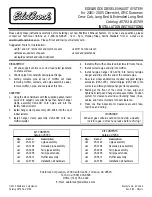
Inflation - Tire Pressure
Tires need the correct amount of air pressure to
operate effectively.
Notice: Do not let anyone tell you that
under-inflation or over-inflation is all right.
It is not. If your tires do not have enough air
(under-inflation), you can get the following:
•
Too much flexing
•
Too much heat
•
Tire overloading
•
Premature or irregular wear
•
Poor handling
•
Reduced fuel economy
If your tires have too much air (over-inflation),
you can get the following:
•
Unusual wear
•
Poor handling
•
Rough ride
•
Needless damage from road hazards
A vehicle specific Tire and Loading Information
label is attached to your vehicle. This label shows
your vehicle’s original equipment tires and the
correct inflation pressures for your tires when they
are cold. The recommended cold tire inflation
pressure, shown on the label, is the minimum
amount of air pressure needed to support
your vehicle’s maximum load carrying capacity.
For additional information regarding how much
weight your vehicle can carry, and an example of
the Tire and Loading Information label, see
Loading the Vehicle on page 4-21. How you load
your vehicle affects vehicle handling and ride
comfort. Never load your vehicle with more weight
than it was designed to carry.
When to Check
Check your tires once a month or more.
Do not forget to check the pressure of the spare
tire. See Spare Tire on page 5-97 for additional
information.
5-65
Summary of Contents for 2009 9-7X
Page 72: ... NOTES 1 68 ...
Page 120: ... NOTES 2 48 ...
Page 123: ... NOTES 3 3 ...
Page 124: ...Instrument Panel Overview 3 4 ...
Page 220: ... NOTES 3 100 ...
Page 274: ...When you open the hood on the 5 3L V8 engine here is what you will see 5 14 ...
Page 276: ...When you open the hood on the 6 0L V8 engine here is what you will see 5 16 ...
Page 389: ...Engine Drive Belt Routing 4 2L L6 Engine 5 3L V8 and 6 0L V8 Engines 6 15 ...
Page 410: ... NOTES 7 18 ...
















































